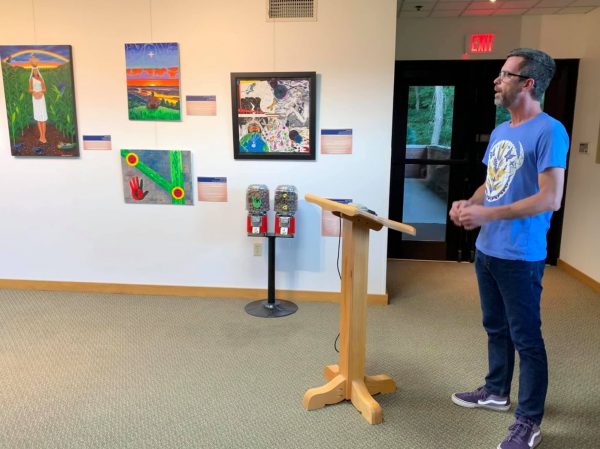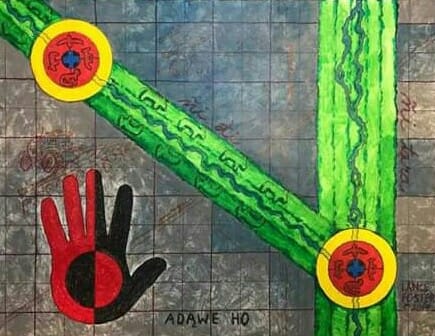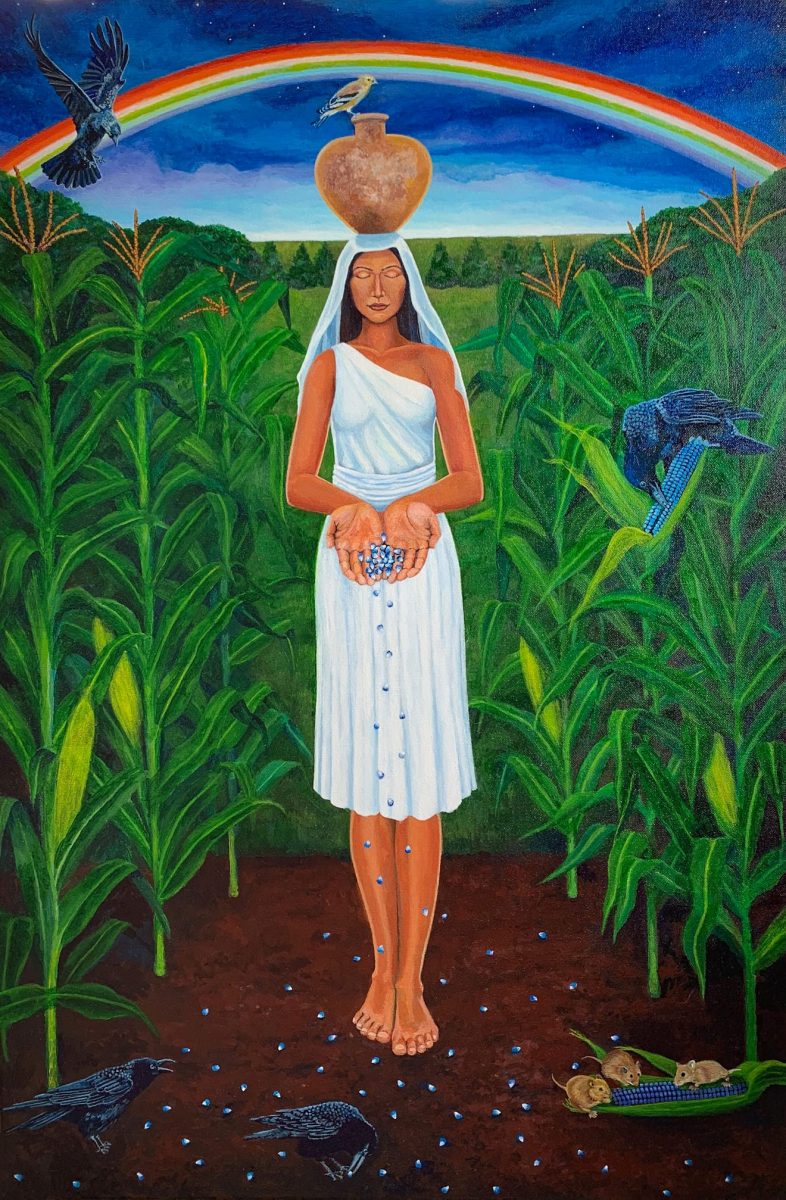BeWildReWild Presents: ReImagining Iowa 5 Ioway Artists
Artwork produced by Lance Foster, Reuben Ironhorse-Kent, Kayla ‘WhiteKnife’ Kent, Sydney Pursel and Philip Pursel. To be displayed at Effigy Mounds National Monument visitor’s center August 31-October 31, 2019.

The state of Iowa takes it’s name from the Ioway tribe. The word Ioway, which has historically been spelled Ayuxwa, Ayoua, and Aiouez among others is actually what the Dakota people called us. The word in their language means “sleepy ones.” European settlers, not realizing that what tribes called each other was not what they called themselves, adopted this word to represent our tribe. But we actually call ourselves Báxoje, the people of the grey snow. Due to a series of treaties and policies of removal and relocation throughout the 1800’s, our tribe no longer resides in their previous territory in present day Iowa. We are now divided into two tribes, one on the border of Kansas and Nebraska and one in Oklahoma.
The land has changed a lot since the time when our Ioway ancestors lived there. The tall grass prairies where they hunted buffalo have been replaced with industrial livestock operations, the woodland forests where they gathered gooseberries chopped down and replaced with fields of corn and soybeans. The place where the Ioway people used to roam has been completely altered and domesticated. The wildness that once was is now dotted with cities full of pollution and crisscrossed with roadways that cut through natural habitats bringing unnecessary material goods on semi trucks.

Imaging Iowa explores a future for Iowa by those whose ancestors used to live harmoniously here, during a time when people were not driven by desires and unessential possessions but took only what was needed for survival. Artists Lance Foster, Kayla Kent, Reuben IronHorse-Kent, Phillip Pursel, and Sydney Pursel are all members of the Ioway Tribe of Kansas and Nebraska and descendants of Iowa’s original inhabitants. Our tribe’s headquarters are now located on a reservation in White Cloud, Kansas with tribal members living throughout the United States and
abroad. The artists in this exhibition live in Columbia, MO, Kansas City, MO; Lincoln, NE; and White Cloud, KS.
We were given the following questions to consider as we created our work:
- What is meant by “wild”?
- What lifestyle changes are needed for humans to live within the bounds of sustainability?
- How can we create a wilder, more beautiful, more biologically diverse, and more enduring Mississippi River watershed?
Each of us approached the topics differently. Some of us investigated history, tribal stories, legends and various realms of consciousness to explore answers. Others looked to our ancestors way of respecting the living and non-living beings of this Earth and beyond. We explored the past to see how our world got to this point and thought about ways we could impact the future. Imagining Iowa highlights the beauty of this
region and the plants and animals that have lived here to assist in changing the way land, resources, and consumption are viewed. Our hope is that people will begin to respect the Earth the way our ancestors did.

Adawe Ho!
by Lance M. Foster (Irogre)
18” x 24”, acrylic and marker
Adawe is a word in our tribal language which means many things: to heed; to give heed to; to pay attention to; to attend to; to watch; to watch on/over; to take care of.
…Ho is not a command, but an exhortation, a hope and a wish, for the one who listens to do what needs to be done, what is good to do.
This work is a representation of the connection between Ni dhi (the Yellow River) and ni tanra (the Great River, the Mississippi) here at Effigy Mounds. This is a connecting corridor, a travel path for animals and plants, along the river systems, like branches that connect to larger branches all the way to the trunk, the largest river. The corridor connects the cores, the places of refuge and reproduction for plants and animals, many of these often at the connecting points along
the rivers. These are places where the animals and plants disperse from and to, to keep the land healthy. And then there are the Bears moving along the river, representing the top carnivores which are only supported by the healthiest of lands, the ones closest to the original ecosystems they have always been a part of.
The grid is how the land was divided up by the Jeffersonian grid of townships and sections, and it is fragmented by human farming, residences, and utilities, which obliterated the original land and its refuges, and even block the flow of life along its corridors.
It is a question people need to ask. Is it possible to have both land that is healthy with its cores, corridors and carnivores as the original communities, and human community needs as well? The hand represents this decision, to harm or to help, red for life and black for death, because it is the same hand of humanity that does both.

Mowotanani
by Lance M. Foster (Irogre)
18” x 24”, acrylic
Some people see unchanged land and call it “wild” or “wilderness.” There is no word for “wild” in our native language, but there is a word in our tribal language for the land the way it was originally made by the Creator, Mowotanani. It is the land functioning as it was supposed to function. People trusted the land because they were part of it and it was part of them, and the seasons followed a pattern, as did life. It was reliable and thus trustworthy.
Here a man sits high on a bluff contemplating the morning, the sun rising over the river valley as the morning star begins to fade. He thinks about all the spirits which are all around him, above and below, which sustain life.
“Wilderness” comes from the idea of self-willed land, land that does as it was created to do, not interfered with. In western culture, the word “wild” is seen in opposition to the word “domestic,” like livestock. We did not have that word “domestic” either; we used the word “captive” or “slave” for the animals that were not “wild.” The same could go for the land that is interfered with and made captive to human purposes. Why do some people not trust the land as it was made by the Creator, functioning and healthy, and sustaining of life, including our own?

ReWilding Concept Piece
by Kayla "WhiteKnife" Kent
2019 Concept, Pen & Ink, Visual
As Humanity makes giant leaps forward in technology and industrial advances, the soul of humanity moves further away from our original connection. Absorbed in the image of ‘good living’ where material items overcome our desires and pollute the lands once they no longer fulfill the endless need. By consciously making the decision to pull your spirit back reconnecting to your CULTURE. Bring back HOLISTIC MEDICINE. TEACHING. ANCESTORAL KNOWLEDGE.
It is then we can take the steps to RESTORE Mother Earth. These actions are slowly being introduced today, we still need warriors.
I’ve entitled this piece “Connected/Disconnected”. A broadened look on the spectrum of restoration.
Every being holds a spirit within, every religion and belief starts from the idea of an origin of creation. The piece “Connected/Disconnected” brings to light the very thin line between our spiritual misguidance and the self-created barrier we form in relation to the natural world.
Included in the piece are various footprints of animals native to Iowa and specific animals located throughout the Midwest. The footprints are aligned above the strip of the 4 direction colors (4 areas of wellness (spiritual, mental, physical, emotional)) to signify the unsaid knowing that animals remain within the natural law.
Once the individual begins the journey to return to the self, we can begin to heal the land, wildlife and each other.

Square the Circle the Square
by Reuben IronHorse-Kent
White Cloud, Kansas, Acrylic/Ink
‘No problem can be solved from the same level of consciousness that created it’.-Albert Einstein.
The three stated questions require lengthy, convoluted and drawn out verbal responses in the extreme, and then only with a dedicated ‘futurist’, accompanied with all manner of detailed technical information.
I am not that individual.
However,
They serve to inspire an attempt to capture a compressed history of how we have arrived at this place and moment in time with the current existing conditions.
Hearing the word mosaic used when speaking of life and the world is, I believe a misnomer. I would disagree and offer more graphic, three dimensional terms. The word that comes to mind is kaleidoscope, one with lenses far away and beyond our grasp, yet being unintentionally
manipulated by humanity.
This may not provide insight to easy answers, but a hope that once we grasp how this situation has occurred, a spark of clarity may give a clearer direction for future generations.
Welcome to the anthropocene…

ReWilding “Seed Bomb” Machine
by Sydney Pursel
2019, Candy machine, red clay, compost, wildflower seeds, milkweed seeds
Bees, birds, and butterflies hold a special place in my heart both personally and culturally as a member of the Ioway tribe of Kansas and Nebraska. It pains me to see these species struggle as their habitats have been lost to industrial farming and urbanization that has completely altered the landscape. Monarch butterfly populations rely on milkweed to survive their massive migrations. Industrial farms spray chemicals that eradicate milkweed and cities lack areas for milkweed to grow leaving butterflies traveling through parts of the Midwest especially vulnerable. Through the planting of wildflowers including milkweed, we can help restore habitats that butterflies and other species rely on.
Seed bombing is just one small way each of us can make a difference! Seed bombs are a mixture of seeds and soil that can be dried and dispersed. The protective layer of soil and clay around the seeds assist with germination and prevents birds and other animals from eating them. These seed bombs include a mixture of wildflower and milkweed seeds. Seed bomb areas you think would benefit from wildflowers that attract birds and bees and provide safe havens for butterflies. Plant them in the fall to bloom the following spring.
Due to regulations, PLEASE DO NOT PLANT AT EFFIGY MOUNDS NATIONAL MONUMENT!
Wildflower seeds
Black eyed susan – Rudbeckia hirta
Blue eyed grass – Sisyrinchium campester
Brown eyed susan – Rudbeckia triloba
Columbine – Aquilegia canadensis
Golden alexanders – Zizia aurea
Grey headed coneflower – Ratibida pinnata
Harebell – Campanula rotundifolia
Large flowered beardstongue – Penstemon grandiflorus
Meadow blazing star – Liastris ligulistylis
Ohio spiderwort – Tradescantia ohioensis
Pale purple coneflower – Echinacea pallida
Partridge pea – Chamaechrista fasciculata
Prairie blazing star – Liatris pycnostachya
Prairie ragwort – Senecio plattensis
Prairie spiderwort – Tradescantia bracteata
Purple prairie clover – Dalea purpurea
Rattlesnake master – Eringia yuccafolia
Rough or button blazingstar – Liatris aspera
Showy goldenrod – Solidago speciosa
Sky blue aster – Aster azureus
Starry campion – Silene stellata
Wild bergamot – Monarda fistulosa
Milkweed seeds
Bloodflower – Asclepias curassavica
Butterfly milkweed – Asclepias tuberosa
Common milkweed – Asclepias syriaca
Showy milkweed – Asclepias speciosa
Swamp milkweed – Asclepias incarnata

Corn Maiden
by Phillip Pursel
2019, Acrylic on canvas
We no longer respect the Earth in the ways our people once did before industry and technology. Arrogance and greed convinced men that humans are smarter than any animal in nature. They tried to control the land for profit and now it is dying. We need to step back, lose our egos, and learn from nature. Not one animal on this planet has had a destructive impact on Earth as human kind has. We need to respect and live as one with nature, the way our ancestors did in the not so distant past in order to ReWild. In this painting a Corn Maiden is giving offering to the plants, animals, and water surrounding her. It portrays respect for the Earth in the time before a desire for material possessions controlled us. It honors a time when people took only what they needed for survival.
